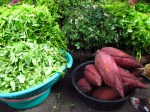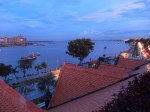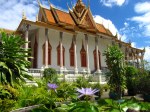There are some odd things about Phnom Penh. It is where the Tonle Sap river starts to flow backwards in the rainy season. The numbering of the streets is difficult to follow – the first street back from the river is 13th street and the 6th street back is 53rd street. Although the entire city of 1.2 million people or so is dead flat, apart from one very minor mound – you could not really call it a hill – it is named after that small mound. “Phnom” means “hill” or “mountain”. The story goes that in 1372 a woman called Penh found 4 statues of Buddha in the river, and ordered that a mound be built for them to be kept on top of it.
The city lies at the confluence of three rivers – Tonle Sap, the Mekong river and Tonle Bassac. Here the Mekong turns east after its long journey from China through Laos, and heads through Vietnam and the Delta.
Unlike most Asian cities, Phnom Penh does not turn its back on the rivers. Hotels, restaurants and shops flourish along Sisawath Quay. The Royal Palace faces the river across a grass square. Five star hotels and new embassy buildings sit on the river’s edge.
Phnom Penh is a much smaller city than Saigon. Its streets are not flooded with motorbikes, and there is a more aesthetic sense to the buildings and the decorations. The famous old buildings – the Royal Palace, the Silver Pagoda and the National Museum – are each far more beautiful than any building in Vietnam. The rooftop bars along the river are irresistible, the best-known being the Foreign Correspondents’ Club. A cocktail or two as the day fades and the lights of the small cruise boats appear, washes reality away.
Eating is another highlight. Cambodian food is little-known internationally compared to that of its neighbours, Thailand and Vietnam. It is more subtle than Thai food, and less dependent on rice noodle soups, rice paper rolls and other rice products than is Vietnamese. A fish sour soup followed by a chicken amok, with an Anchor beer or two, is hard to beat. Metro and Fish on Sisawath Quay are restaurants that are worth a visit for modern Cambodian food.
Like most of south east Asia, markets are the lifeblood of daily life in Phnom Penh. Kandal markets on the corner of 13th and 148th streets is good fun for a wander around the fresh food stalls and to take advantage of the many photo opportunities. The most famous markest are the Russian market, which is a dark, unappealing rabbit warren, and Central market in the splendid old star-shaped French building, which has been completely renovated, is light and clean, although somewhat sterile by Asian standards. The night market on Sisawath Quay at 108th street, where Fish restaurant is on the corner, operates on Friday and Saturday nights and is good fun.
There is plenty of other good shopping. streets like 240th and 178th have plenty of opportunities to open the wallets. Monument Books on Norodom Boulevard near 240th street is a treasure for those of us who live in bookshop-starved in Vietnam, and the new boutique of Artisans d’Angkor on 13th street opposite the Post Office near 100th street is a wonderful display of its beautiful carvings and silk weavings and other crafts. Artisans is an NGO which promotes Khmer art and culture and provides training and opportunities for impoverished rural youth.
Give Phnom Penh a go – it’s worth it.
- Lemongrass-skewered fish at Kandal markets
- Banana blossom flower at Kandal markets
- Kandal markets
- Night markets
- The rooftop bar at the Quay hotel
- Metro restaurant
- Fish restaurant
- Siesta time at the Museum
- National Museum
- Internal courtyard at the Museum
- National Museum from the FCC
- Lunch at the Foreign Correspondents’ Club
- Silver pagoda
- Silver pagoda
- A beautiful but largely-overlooked fresco in the grounds of the Silver Pagoda
- In the Royal Palace grounds
- Royal Palace
- Going for walkies outside the Royal Palace grounds




















